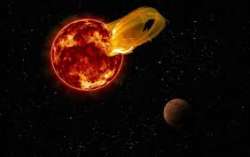New exoplanet twice the size of Earth found, 145 light years away
The exoplanet 'Wolf 503b' is in the Virgo constellation and it orbits its star every six days and is thus very close to it, about 10 times closer than Mercury is to the Sun.

Using data from NASA's Kepler Space Telescope, an international team of scientists has discovered a new exoplanet twice the size of Earth and about 145 light years away.
The exoplanet 'Wolf 503b' is in the Virgo constellation and it orbits its star every six days and is thus very close to it, about 10 times closer than Mercury is to the Sun.
"'Wolf 503b' is one of the only planets with a radius near the gap that has a star that is bright enough to be amenable to more detailed study that will better constrain its true nature," explained Bjorn Benneke, Professor at the Universite de Montreal in Canada.
"It provides a key opportunity to better understand the origin of this radius gap as well as the nature of the intriguing populations of 'super-Earths' and 'sub-Neptunes' as a whole."
In order to better characterise the system 'Wolf 503b' is part of, the astronomers first obtained a spectrum of the host star at the NASA Infrared Telescope Facility.
This confirmed the star is an old "orange dwarf", slightly less luminous than the Sun but about twice as old, and allowed a precise determination of the radius of both the star and its companion, the researchers explained, in a paper published in the Astronomical Journal.
Further, the 'Wolf 503b' system is relatively closer to Earth, and thus very bright.
"By investigating the nature of 'Wolf 503b', we'll understand more about the structure of planets near the radius gap and more generally about the diversity of exoplanets present in our galaxy," said Merrin Peterson, a graduate student at the varsity.